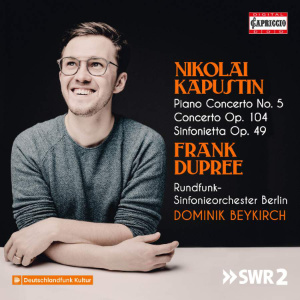
Nikolai Kapustin (1937-2020)
Piano Concerto No.5, Op.72 (1993)
Concerto for two pianos and percussion, Op.104 (2002)
Sinfonietta for piano four-hands, Op.49 (1986)
Frank Dupree (piano)
Adrian Brendle (piano: Concerto for two pianos, Sinfonietta)
Rundfunk-Sinfonieorchester Berlin/Dominik Beykirch
rec. 2022, Haus des Rundfunks, Berlin; SWR Funkstudio, Stuttgart
Capriccio C5495 [58]
By my reckoning Capriccio has produced four Kapustin discs promoted on the back of their booklet; Piano Concerto No. 4 and the Double Concerto, the Cello Concerto, Saxophone chamber music and finally music for jazz trio. I’ve heard them all and they have been uniformly excellent, lively and brilliantly conceived absorptions of jazz in various guises.
Now it’s time for three works from adjacent decades, the 1986 Sinfonietta for piano four-hands, the Piano Concerto No.5 from 1993 and finally 2002’s Concerto for two pianos. The clearly sectional but one-movement Concerto No.5 is graced with scintillating piano writing, sometimes quixotic as well, Gershwinesque in places in both piano and orchestral writing. Because Kapustin notated everything, and there is no room for improvisation, it’s remarkable that he writes so idiomatically and attractively, syncopating seemingly at will, and integrating the solo and orchestral tissues of his score with such bravura. He creates the illusion of freedom and quasi-improvisation whilst retaining idiomatic control. This includes the ‘string bass’ passage over which he spins a sinuous and seductive line and the catchy themes over the hard-working percussion. There’s a Gershwinesque cadenza and a truly rolling, raunchy end to this big band concerto.
The Concerto for two pianos and percussion is another example of his legerdemain in convincing the listener that the soloists are improvising. There’s a large percussion kit which brings plenty of colour and it starts this breezy three-movement work with bop-soul touches – think Horace Silver – and the opening movement ends with the pianists imitating the locked hands and block chords of George Shearing or Milt Buckner. The kinetic energy generated by the drums and percussion in the central movement – Meinhard Jenne plays the drum set, Franz Bach the percussion – leads fluidly throughout before returning, via piano trills, to the calm mood of the opening. There are hints of Cubano Chant in the finale in the percussion, then the piano duo come on strong, crisply accenting, flinging hints of Erroll Garner to the four winds. Brilliant stuff.
The Sinfonietta is a four-movement piece – Overture, Slow Waltz, Intermezzo and a Rondo. The opening is snappy and swings mightily, whilst the Waltz is slow and contrastive, opening up a refined element – though I’m not sure I share the description of a ‘cocktail bar’ advanced in the sleeve notes. We are back on track with a tricksterish, rollicking Intermezzo and the finale ends with jovial, warm, decisive bravura.
The main burdens fall on Frank Dupree who plays with masterful insouciance but Adrian Brendle shows equally fine chops in the two-piano concerto and the Sinfonietta. The Rundfunk-Sinfonieorchester Berlin under Dominik Beykirch only has the one outing, in the Fifth Concerto, but receives a fine recording and plays splendidly.
Kapustin music is just the thing for jazz-enriched and big band panache. Dupree et al have it just right here. No wonder the pianist is smiling on the cover picture; he deserves to, as well.
Jonathan Woolf
Help us financially by purchasing from





















